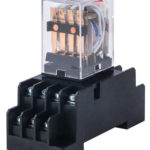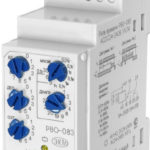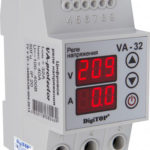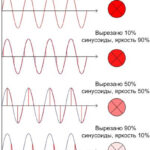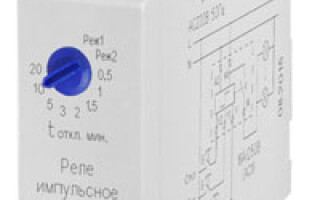For a comfortable stay today, many houses and apartments use automated systems with electronics. You may have already heard about walk-through and mid-flight switches: they help to assemble a lighting control circuit in several places. Despite the practicality of the principles of operation of such a system with wiring, as well as its connection, it is not too simple. However, there is a simpler option - the use of an interesting bistable device, which is also called an impulse relay.
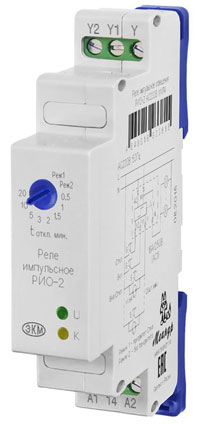
Content
Purpose and where it is applied
This switch is designed to turn on or off the load when a signal is applied to the contacts. The relay is called bistable because the on/off switch occurs exactly when a signal is applied to the control input.And in the same position the relay remains after the end of the input signal.
It is noteworthy that even after being disconnected from the mains, the impulse relay “remembers” the last position of the contacts, and when turned on, it resumes the state that it was before it was turned off.
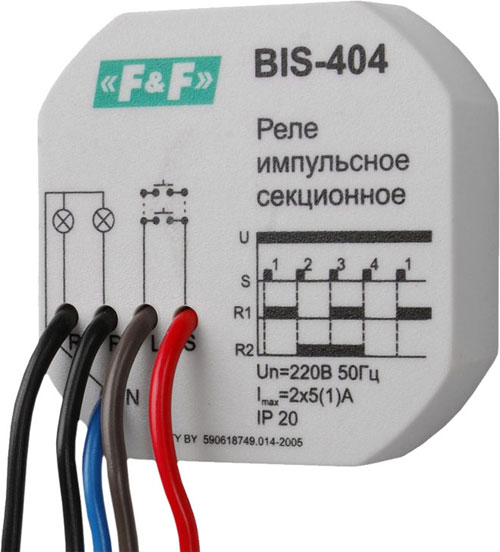
In everyday life, this device is used very often due to its convenience, since lighting can be controlled from at least two points. For example, the light turned on in the bedroom, and the light turned off in the corridor before leaving the apartment. Such a system will come in handy in the case when the premises are very long and large in size.
ATTENTION! In addition to comfort, the impulse relay also offers a solution for protection and signaling tasks. For example, in industrial firms where high electrical power is required, the device ensures the safety of the operator due to the fact that it operates from low voltage and can be controlled remotely.
Principle of operation and appearance
Generally speaking, a relay is an electrical mechanism that closes or breaks an electrical circuit. Its work is carried out on the basis of electrical or other parameters that act on it.
When choosing the operating mode of the relay, one must be guided by the frequency of switching on, the magnitude of the current, as well as the nature of the loads being tested.
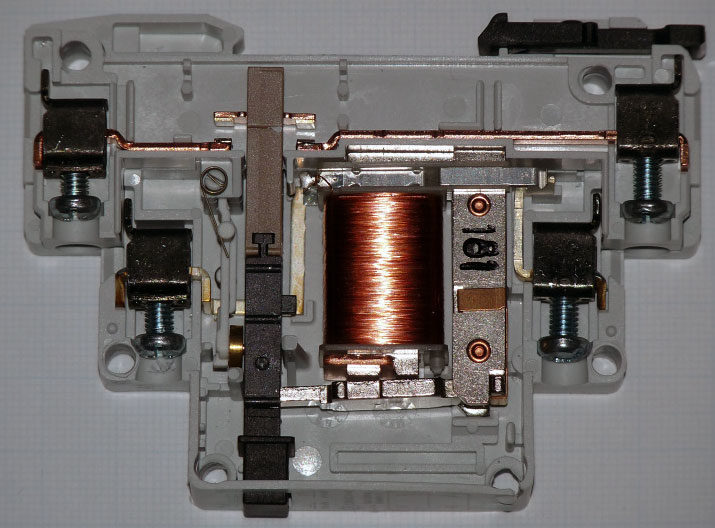
The design consists of the following components:
- Coils.
The coil is a copper wire that is wound around a non-magnetic material; may be in fabric insulation or be covered with a special varnish that does not allow electricity to pass through; - core.
It contains iron and comes into action when current passes through the turns of the coil; - Movable anchor.
Such an armature is a plate attached to the armature, it acts on the closing contacts; - contact system.
It is a circuit status switch.
The operation of the relay is based on the electromagnetic force that appears in the core of the coil when current is passed through it.
The coil is a retractable device in which the core is connected to a movable armature. It also activates the power contacts. And a resistor can be additionally connected to the coil to increase the accuracy of operation.
Varieties of impulse relays
IMPORTANT! A bistable relay is a relay that can be in two fixed (stable) states. Due to the nature of the application of this device, it is sometimes called a "blocking" relay, as it blocks the network in one state.
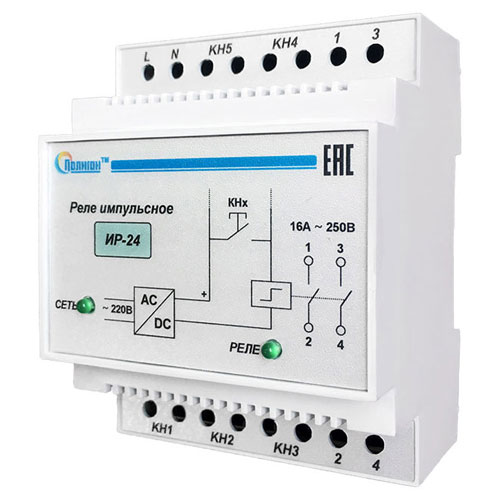
There are big differences between some relays, so they can be divided mainly into 2 categories:
- electromechanical relays;
- electronic impulse relays.
Electromechanical
This type of device consumes electricity only at the time of operation. The locking mechanism ensures high reliability and saves electricity. The system works well: it means protection against fluctuations in the network, which lead to false positives.
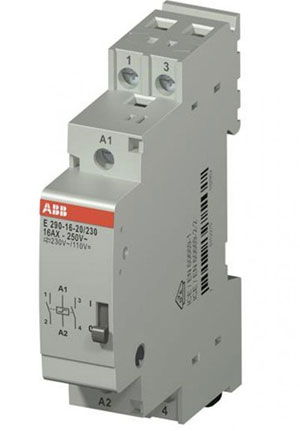
The design is based on: a coil, contacts, a mechanism with buttons for turning on and off.
Relays of the electromechanical type are considered more reliable and convenient to use, as they are not afraid of interference. Plus, there are no high requirements for the installation site.
Electronic
Electronic impulse relays have a characteristic feature: they use microcontrollers.Thanks to this, they have extended functionality. For example, such devices allow you to add a timer. Other additional features help in building complex lighting systems.

At the heart of the design: an electromagnetic coil, microcontrollers, semiconductor switches.
Electronic relays are more popular than other types due to the functionality and variety that can be added to them: you can create products for lighting of any complexity. It is also possible to select them for any voltage - 12 volts, 24, 130, 220. Depending on the installation, such relays can be DIN-standard (for electrical panels) and conventional (with other mounting methods).
Main technical characteristics
Relays can be classified according to the following parameters, depending on the purpose and scope:
- the return coefficient is the ratio of the armature output current to the pull-in current;
- output current is the maximum value of the current in the coil when the armature exits;
- retraction current - the minimum value of the current in the coil when the armature returns to its original position;
- setting - the value of operation within the limits specified in the relay;
- trigger value - the input signal to which the device responds automatically;
- nominal values are voltage, current and other quantities that underlie the operation of the relay.
Electromagnetic relays can also be divided according to the response time. Such a device has such a parameter as a long delay - more than 1 second, with the ability to configure. Next come slow - 0.15 seconds, normal - 0.05 seconds, high-speed, the fastest inertialess - less than 0.001 seconds.
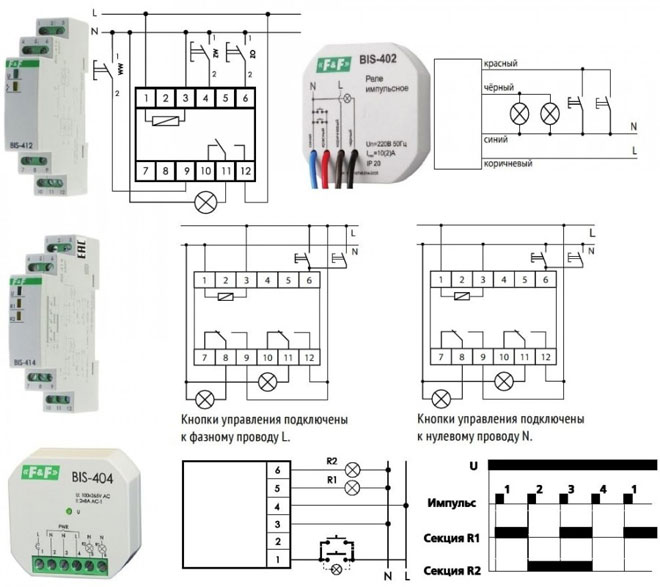
Other technical characteristics of the impulse relay can be:
- maximum load with incandescent lamps;
- number and type of contacts;
- Operating temperature range;
- relative humidity;
- and etc.
Wiring diagrams
The impulse relay is very often used with the connection of several pushbutton spring return switches. They must be connected in parallel to each other according to all requirements.
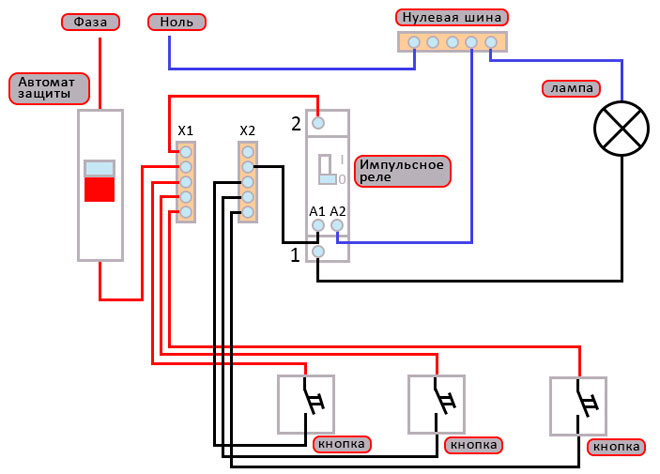
To organize a lighting control circuit, connect the power wire to a bistable relay. And the switches are interconnected by means of wiring. Thanks to this, in the future it is possible to de-energize the entire network using just one switch.
This option is popular because it simplifies installation. At the same time, it is necessary to calculate the characteristics accurately: for example, support for LED backlighting of buttons so that the network functions fully.
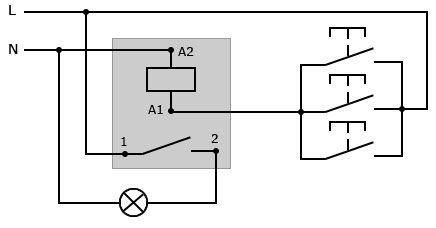
To make it more convenient, you can check the markings. Manufacturers use designations such as:
- A1-A2 - coil contacts;
- 1-2 (or other numbers) - the number of contacts that close or open during operation of the bistable relay;
- ON-OFF - marking of contacts that switch the relay to the off or on state (used when installing the central control).
REFERENCE! As a rule, a 220 volt relay is used to connect to a power shield. In this case, cables are connected to the contacts, and further control is carried out through an impulse relay. And individual switches throughout the lighting system are connected by wires.
Advantages and disadvantages
The main types of relays have many advantages over semiconductor switches, such as:
- relatively low cost (due to inexpensive components);
- there is a powerful isolation between the coil and the contact group;
- are not subject to the harmful effects of overvoltage, lightning interference, switching of powerful electrical installations;
- there is control of lines with a load of up to 0.4 kV (with a small volume of the device).
An additional plus is the absence of a cooling problem and harmlessness to the atmosphere. For example, when closing with a current of 10 A, less than 0.5 W is distributed over the coil in the relay. In comparison with electronic counterparts, this value is higher than 15 watts.
Disadvantages of an impulse relay:
- wear, as well as problems of switching inductive loads and high voltages (if the current is constant);
- radio interference occurs when the circuit is turned on and off, so shielding is required;
- relatively long response time.
A serious disadvantage can be considered continuous wear during switching (deformation of springs, oxidation of contacts, for example).
However, it is worth clarifying that when using electronic relays, there are such advantages as: security, good connection speed, market availability, silent operation, advanced functionality. And among the minuses: overheating when switching high currents, disruption in case of power outages, resistance in the closed position, etc.
Nevertheless, electronic relays are developing quite steadily and quickly. They are popular due to their functionality, which can be extended relatively easily.
Conclusion
Modern lighting and electrification systems use a pulse relay very actively. Market requirements for manufacturers of such relays are becoming ever higher, which gives rise to continuous development in this area.
Most users require advanced functionality and flexibility in lighting control. Therefore, demand stimulates supply, as this technology is in great demand today.
Similar articles:
